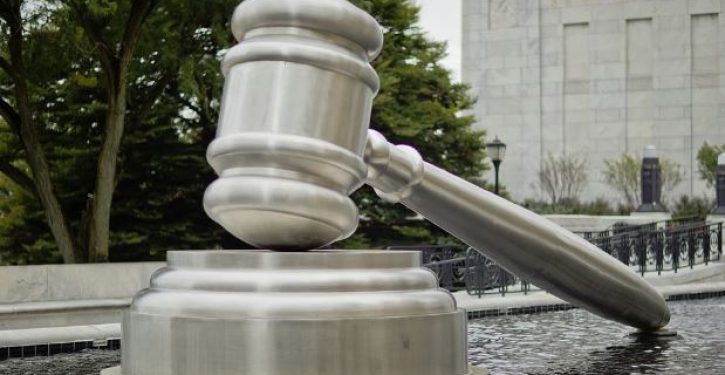
If you sue over something embarrassing, you might want to do so anonymously. But different judges have radically different ideas about when it is OK to let someone sue as “John Doe” or “Jane Roe,” and when it is not OK to allow that. The Supreme Court has never provided any guidance on when anonymous lawsuits are OK, even though one of its most famous cases — Roe v. Wade — involved an anonymous plaintiff. But courts recognize exceptions for when people can sue anonymously, although courts in different parts of the country recognize different exceptions and interpret the same exceptions differently.
As a law professor notes, the Supreme Court has never explained when pseudonymity should be allowed. It allows or denies requests to file petitions for certiorari anonymously, but doesn’t explain why it allows one person to do it, but not another person. (See, e.g., Doe v. Mich. Att’y Grievance Comm’n (1996) (denying); Foe v. Cuomo (1990) (granting)).
Cutting against anonymous lawsuits is the fact that the Supreme Court has recognized right of access to judicial records rooted in the common law. (See Nixon v. Warner Communications (1978)).
Also, the Federal Rules of Civil Procedure suggest that anonymous lawsuits should be the exception rather than the rule. On the one hand, they mandate pseudonymity for minors, in Federal Rule of Civil Procedure 5.2(a)(3)). On the other hand, courts have inferred a presumption against pseudonymity from Rule 10(a), which says that “The title of the complaint must name all the parties”, and Rule 17(a), which says that “An action must be prosecuted in the name of the real party in interest.” See Doe v. Frank (1992). But the Rules say nothing about when pseudonymity is nevertheless allowed.
The federal appeals courts have divided into three different schools of thought about this.
The federal appeals court in Chicago permits pseudonymity only where the litigant “is a minor, is at risk of physical harm, or faces improper retaliation (that is, private responses unjustified by the facts as determined in court).”
Ten other federal appeals courts apply different non-exhaustive, multifactor tests for when to allow a plaintiff to sue anonymously. (See, e.g., United States v. Pilcher (2020) (ten factors); Femedeer v. Haun (2000)).
The federal appeals court in Boston rejects both a multifactor test and “sharp, categorial exceptions to the strong presumption against pseudonymity,” and instead identifies “four general categories of exceptional cases in which party anonymity ordinarily will be warranted.” (See Doe v. Massachusetts Institute of Technology (2022).
Judges also differ on how to apply these three schools of thought on when to allow anonymous lawsuits. Lower courts that adopt various multifactor tests disagree on how to interpret each factor, generally without acknowledging the disagreement. As a law professor explains:
[1.] Consider, for instance, a recurring question: Does risk of reputational, economic, or professional harm suffice to let a litigant proceed pseudonymously? Most courts generally say no: “That a plaintiff may suffer embarrassment or economic harm is not enough.” Doe v. Megless, 654 F.3d 404, 408 (3d Cir. 2011)….
But other courts do permit pseudonymity in some such cases. In one recent sexual assault lawsuit, for instance, the judge let the defendant proceed pseudonymously, reasoning, “[T]he court finds that the chance that [defendant] would suffer reputational harm is significant. The defendant is a partner of a well-known law firm in New York and an adjunct law school instructor.” Doe v. Doe, No. 20-cv-5329, 2020 WL 6900002, *3 (E.D.N.Y. Nov. 24, 2020).
Likewise, in a lawsuit over an allegedly false credit report, the court let plaintiff proceed pseudonymously, because “[p]ublicly identifying Plaintiff risks impeding her future employment prospects by making the improperly disclosed information public knowledge.” Innovative Enters., Inc., No. 20-cv-00107, at 4-5. Another court did the same in a libel lawsuit. Alexander v. Falk, No. 16-cv-02268, 2017 WL 3749573, *5 (D. Nev. Aug. 30, 2017). Some cases that discuss a party’s mental health condition have likewise permitted pseudonymity on the theory that identifying the plaintiffs could lead to “severe” “economic and career consequences.” Elson S Floyd Coll. of Med., 2021 WL 4197366, *2.
Some courts have also permitted pseudonymity for whistleblowers, out of a concern that being known as a whistleblower might create “a reasonably credible threat of some professional harm.” SEB Inv. Mgmt. AB v. Symantec Corp., No. 18-cv-02902, 2021 WL 3487124, *2 (N.D. Cal. Aug. 9, 2021). One court has permitted pseudonymity to a doctor challenging her employer’s report of “charge[s] of professional misconduct” to “the National Practitioner Data Bank.” Doe v. Lieberman, No. 20-cv-02148, 2020 WL 13260569, *3 (D.D.C. Aug. 5, 2020). And one court permitted a defendant who was being accused of trade secret infringement to litigate pseudonymously. Ipsos MMA, Inc. v. Doe, No. 21-cv-08929, 2022 WL 451510, *2 (S.D.N.Y. Jan. 25, 2022).
[2.] Many of the multifactor tests list as one factor “whether the suit … challeng[es] the actions of the government or that of private parties.” Sealed Plaintiff, 537 F.3d at 190. But which way does that factor cut?
Some courts conclude that pseudonymity is less available in suits against the government, because “there is a heightened public interest when an individual or entity files a suit against the government.” In re Sealed Case, 971 F.3d 324, 329 (D.C. Cir. 2020); see also, e.g., Megless, 654 F.3d at 411. Others take the opposite view, concluding that pseudonymity is less available in suits against private parties, because “[w]hile such [pseudonymous] suits involve no injury to the Government’s reputation, the mere filing of a civil action against other private parties may cause damage to their good names and reputation and may also result in economic harm.” S. Methodist Univ. Ass’n of Women L. Students v. Wynne & Jaffe, 599 F.2d 707, 713 (5th Cir. 1979); see also, e.g., Doe v. Skyline Autos., 375 F. Supp. 3d 401, 406 (S.D.N.Y. 2019); Doe v. Va. Polytechnic Inst. & State Univ., No. 19-cv-00249, 2020 WL 1287960, *4 (W.D. Va. Mar. 18, 2020); EW v. N.Y. Blood Ctr., 213 F.R.D. 108, 111 (E.D.N.Y. 2003).
[3.] What about actual or predicted future media interest in a case? Some courts, applying the “public’s interest in the litigation” factor of the multifactor tests, say that “the public’s interest” in the case “weigh[s] against” pseudonymity. See, e.g., Doe 1 v. United States, No. 24-cv-1071, 2024 WL 1885188, *4-5 (S.D.N.Y. Apr. 30, 2024), reconsideration denied, No. 24-cv-1071, 2024 WL 3738626 (S.D.N.Y. Aug. 8, 2024); Doe v. [Harvey] Weinstein, 484 F. Supp. 3d 90, 95, 97 (S.D.N.Y. 2020). Others downplay the significance of the factor. See, e.g., Fowler, 537 F. Supp. 3d at 528 n.38; Doe v. [Tupac] Shakur, 164 F.R.D. 359, 362 (S.D.N.Y. 1996). Others treat it as favoring pseudonymity, on the theory that such public interest and media attention would unduly harm plaintiff’s privacy. See, e.g., M.J.R. v. United States, No. 23-cv-05821, 2023 WL 7563746, *2 (N.D. Cal. Nov. 14, 2023); Trooper 1 v. N.Y. State Police, No. 22-cv-893, 2022 WL 22869548, *4-5 (E.D.N.Y. June 9, 2022); Doe v. United Airlines, Inc., No. 17-cv-2825, 2018 WL 3997258, *2 (D. Nev. Aug. 21, 2018); Doe v. County of Milwaukee, No. 14-C-200, 2015 WL 5794750, *2 (E.D. Wis. Oct. 2, 2015). And all these cases involved a similar reason for pseudonymity: plaintiffs’ privacy interest in concealing their identities as alleged sexual assault victims.
[4.] Consider another commonly cited factor, the age of the plaintiff. Under Rule 5.2, courts generally let minors sue pseudonymously. But what about young adults? Some courts conclude that the age factor counts only in favor of under-18-year-olds. See, Volokh, supra, at 1401 & n.232 (collecting cases). Others suggest the cutoff should be around age twenty. See id. at 1401 & n.233. Still others decline to draw any line. See id. at 1401 & n.231; Doe v. Sheely, 781 F. App’x 972, 973-74 (11th Cir. 2019) (“[C]ourts should be careful not to draw a bright line between a plaintiff one day shy of her eighteenth birthday and a plaintiff one day past it.”).
[5.] As a result of the vagueness of the factors, lower courts sharply divide on particular applications of the factors, and how they are to be balanced. Consider arguments by plaintiffs who are claiming that universities had wrongly found them guilty of sexual assault. Some courts, even outside the Seventh Circuit, conclude that those plaintiffs have to sue under their own names (just like other plaintiffs who allege that they were wrongly accused of sexual assault). See, e.g., Doe v. Rider Univ., No. 16-cv-4882, 2018 WL 3756950, *5 (D.N.J. Aug. 7, 2018) (describing plaintiff’s concerns as “little more than a fear of embarrassment or economic harm”).
But most courts do allow pseudonymity, concluding, for instance, that “requiring Plaintiff to disclose his true identity could cause” “harm to his reputation and future prospects,” which “weighs in favor of allowing Plaintiff to proceed pseudonymously.” See, e.g., Doe v. Rollins Coll., No. 18-cv-1069-ORL-37, 2018 WL 11275374, *4 (M.D. Fla. Oct. 2, 2018); Volokh, supra, at 1423, 1441-48 (citing many cases coming down both ways). And the outcomes in these cases are not even uniform within the same circuit. Compare Doe v. Kenyon Coll., No. 20-cv-4972, 2020 WL 11885928, *1 (S.D. Ohio Sept. 24, 2020) (allowing pseudonymity), with Student Pid A54456680 v. Mich. State Univ., No. 20-cv-984, 2020 WL 12689852, *2 (W.D. Mich. Oct. 15, 2020) (denying pseudonymity).
Indeed, these Title IX cases split lopsidedly in favor of pseudonymity, see Volokh, supra, at 1441-48 (listing 84 cases where pseudonymity was allowed and 16 cases where pseudonymity was not allowed), though courts generally reject pseudonymity in other “harm to … reputation and future prospects” cases (see item 1 above). This is yet another inconsistency to which the vague multifactor tests have led.
[6.] Likewise, consider another recurring fact pattern, in which both litigants and the public should be able to expect consistency: lawsuits alleging that the plaintiff was sexually assaulted. Protection of privacy is a recurring factor in the multifactor tests. Volokh, supra, at 1405-14. And of course a person’s having been sexually assaulted is usually seen as a highly private matter. Yet courts are sharply split on when adults who allege that they were sexually assaulted can sue under a pseudonym. See Volokh, supra, at 1430-37 (citing 67 cases where pseudonymity was allowed and 39 cases where pseudonymity was not allowed).
[7.] Courts are likewise divided when a person seeks to prevent disclosure of a mental illness or disorder. See Volokh, supra, at 1437-41 (listing 16 cases where pseudonymity was allowed and 28 cases where pseudonymity was not allowed, including cases that reach different results for the same mental condition).
[8.] Courts are divided on when pseudonymity is justified to prevent disclosure of a person’s homosexuality or transgender status.…
[9.] Courts are divided on whether preventing disclosure of a person’s communicable disease, such as HIV, justifies pseudonymity….
[10.] And courts are divided on whether defendants accused of infringing copyright in pornographic works are entitled to pseudonymity.



